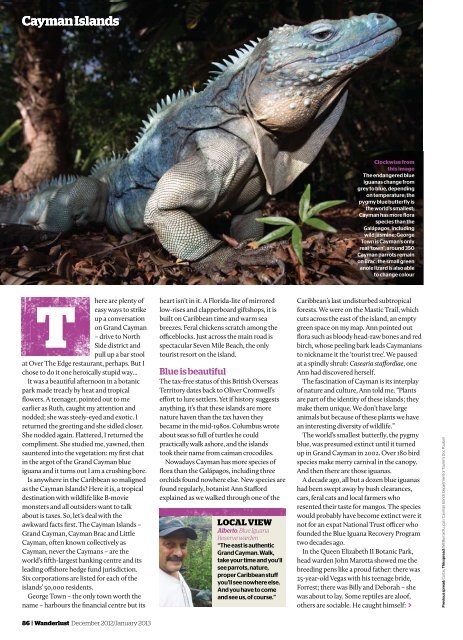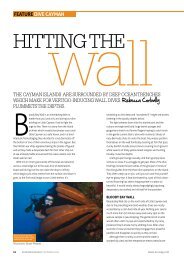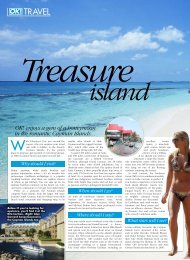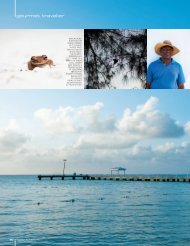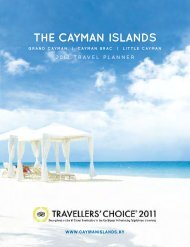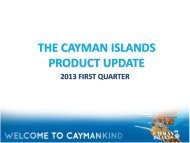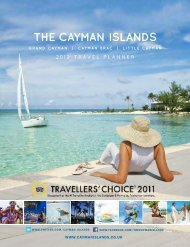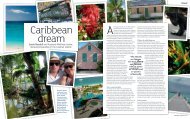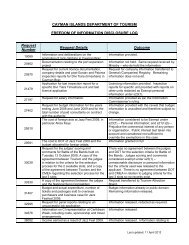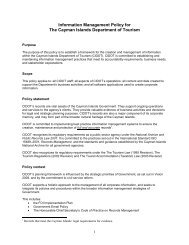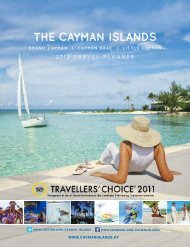Create successful ePaper yourself
Turn your PDF publications into a flip-book with our unique Google optimized e-Paper software.
<strong>Cayman</strong> <strong>Islands</strong><br />
Clockwise from<br />
this image<br />
The endangered blue<br />
iguanas change from<br />
grey to blue, depending<br />
on temperature; the<br />
pygmy blue butterfly is<br />
the world’s smallest;<br />
<strong>Cayman</strong> has more flora<br />
species than the<br />
Galápagos, including<br />
wild jasmine; George<br />
Town is <strong>Cayman</strong>’s only<br />
real ‘town’; around 350<br />
<strong>Cayman</strong> parrots remain<br />
on Brac; the small green<br />
anole lizard is also able<br />
to change colour<br />
here are plenty of<br />
T<br />
easy ways to strike<br />
up a conversation<br />
on Grand <strong>Cayman</strong><br />
– drive to North<br />
Side district and<br />
pull up a bar stool<br />
at Over The Edge restaurant, perhaps. But I<br />
chose to do it one heroically stupid way...<br />
It was a beautiful afternoon in a botanic<br />
park made treacly by heat and tropical<br />
flowers. A teenager, pointed out to me<br />
earlier as Ruth, caught my attention and<br />
nodded; she was steely-eyed and exotic. I<br />
returned the greeting and she sidled closer.<br />
She nodded again. Flattered, I returned the<br />
compliment. She studied me, yawned, then<br />
sauntered into the vegetation: my first chat<br />
in the argot of the Grand <strong>Cayman</strong> blue<br />
iguana and it turns out I am a crushing bore.<br />
Is anywhere in the Caribbean so maligned<br />
as the <strong>Cayman</strong> <strong>Islands</strong>? Here it is, a tropical<br />
destination with wildlife like B-movie<br />
monsters and all outsiders want to talk<br />
about is taxes. So, let’s deal with the<br />
awkward facts first. The <strong>Cayman</strong> <strong>Islands</strong> –<br />
Grand <strong>Cayman</strong>, <strong>Cayman</strong> Brac and Little<br />
<strong>Cayman</strong>, often known collectively as<br />
<strong>Cayman</strong>, never the <strong>Cayman</strong>s – are the<br />
world’s fifth-largest banking centre and its<br />
leading offshore hedge fund jurisdiction.<br />
Six corporations are listed for each of the<br />
islands’ 50,000 residents.<br />
George Town – the only town worth the<br />
name – harbours the financial centre but its<br />
heart isn’t in it. A Florida-lite of mirrored<br />
low-rises and clapperboard giftshops, it is<br />
built on Caribbean time and warm sea<br />
breezes. Feral chickens scratch among the<br />
officeblocks. Just across the main road is<br />
spectacular Seven Mile Beach, the only<br />
tourist resort on the island.<br />
Blue is beautiful<br />
The tax-free status of this British Overseas<br />
Territory dates back to Oliver Cromwell’s<br />
effort to lure settlers. Yet if history suggests<br />
anything, it’s that these islands are more<br />
nature haven than the tax haven they<br />
became in the mid-1980s. Columbus wrote<br />
about seas so full of turtles he could<br />
practically walk ashore, and the islands<br />
took their name from caiman crocodiles.<br />
Nowadays <strong>Cayman</strong> has more species of<br />
flora than the Galápagos, including three<br />
orchids found nowhere else. New species are<br />
found regularly, botanist Ann Stafford<br />
explained as we walked through one of the<br />
Local view<br />
Alberto, Blue Iguana<br />
Reserve warden<br />
“The east is authentic<br />
Grand <strong>Cayman</strong>. Walk,<br />
take your time and you’ll<br />
see parrots, nature,<br />
proper Caribbean stuff<br />
you’ll see nowhere else.<br />
And you have to come<br />
and see us, of course.”<br />
Caribbean’s last undisturbed subtropical<br />
forests. We were on the Mastic Trail, which<br />
cuts across the east of the island, an empty<br />
green space on my map. Ann pointed out<br />
flora such as bloody head-raw bones and red<br />
birch, whose peeling bark leads <strong>Cayman</strong>ians<br />
to nickname it the ‘tourist tree’. We paused<br />
at a spindly shrub: Casearia staffordiae, one<br />
Ann had discovered herself.<br />
The fascination of <strong>Cayman</strong> is its interplay<br />
of nature and culture, Ann told me. “Plants<br />
are part of the identity of these islands; they<br />
make them unique. We don’t have large<br />
animals but because of these plants we have<br />
an interesting diversity of wildlife.”<br />
The world’s smallest butterfly, the pygmy<br />
blue, was presumed extinct until it turned<br />
up in Grand <strong>Cayman</strong> in 2002. Over 180 bird<br />
species make merry carnival in the canopy.<br />
And then there are those iguanas.<br />
A decade ago, all but a dozen blue iguanas<br />
had been swept away by bush clearances,<br />
cars, feral cats and local farmers who<br />
resented their taste for mangos. The species<br />
would probably have become extinct were it<br />
not for an expat National Trust officer who<br />
founded the Blue Iguana Recovery Program<br />
two decades ago.<br />
In the Queen Elizabeth II Botanic Park,<br />
head warden John Marotta showed me the<br />
breeding pens like a proud father: there was<br />
25-year-old Vegas with his teenage bride,<br />
Forrest; there was Billy and Deborah – she<br />
was about to lay. Some reptiles are aloof,<br />
others are sociable. He caught himself: ><br />
Previous spread: Corbis. This spread: Will Burrard-Lucas / <strong>Cayman</strong> <strong>Islands</strong> Department of Tourism; Doc Poulson<br />
86 | Wanderlust December 2012/January 2013


